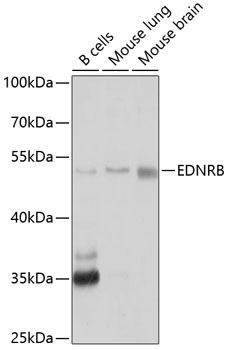Cell Biology Antibodies 8
Anti-EDNRB Antibody (CAB2908)
- SKU:
- CAB2908
- Product Type:
- Antibody
- Reactivity:
- Human
- Reactivity:
- Mouse
- Host Species:
- Rabbit
- Isotype:
- IgG
- Research Area:
- Cell Biology
Description
| Antibody Name: | Anti-EDNRB Antibody |
| Antibody SKU: | CAB2908 |
| Antibody Size: | 20uL, 50uL, 100uL |
| Application: | WB |
| Reactivity: | Human, Mouse |
| Host Species: | Rabbit |
| Immunogen: | Recombinant fusion protein containing a sequence corresponding to amino acids 1-100 of human EDNRB (NP_001116131.1). |
| Application: | WB |
| Recommended Dilution: | WB 1:500 - 1:2000 |
| Reactivity: | Human, Mouse |
| Positive Samples: | B cells, Mouse lung, Mouse brain |
| Immunogen: | Recombinant fusion protein containing a sequence corresponding to amino acids 1-100 of human EDNRB (NP_001116131.1). |
| Purification Method: | Affinity purification |
| Storage Buffer: | Store at -20'C. Avoid freeze / thaw cycles. Buffer: PBS with 0.02% sodium azide, 50% glycerol, pH7.3. |
| Isotype: | IgG |
| Sequence: | MQPP PSLC GRAL VALV LACG LSRI WGEE RGFP PDRA TPLL QTAE IMTP PTKT LWPK GSNA SLAR SLAP AEVP KGDR TAGS PPRT ISPP PCQG PIEI KETF |
| Gene ID: | 1910 |
| Uniprot: | P24530 |
| Cellular Location: | Cell membrane, Multi-pass membrane protein |
| Calculated MW: | 48kDa/49kDa/59kDa |
| Observed MW: | 49kDa |
| Synonyms: | EDNRB, ABCDS, ET-B, ET-BR, ETB, ETB1, ETBR, ETRB, HSCR, HSCR2, WS4A |
| Background: | The protein encoded by this gene is a G protein-coupled receptor which activates a phosphatidylinositol-calcium second messenger system. Its ligand, endothelin, consists of a family of three potent vasoactive peptides: ET1, ET2, and ET3. Studies suggest that the multigenic disorder, Hirschsprung disease type 2, is due to mutations in the endothelin receptor type B gene. Alternative splicing and the use of alternative promoters results in multiple transcript variants. |
| UniProt Protein Function: | ETB: a G protein-coupled receptor which activates a phosphatidylinoitol-calcium second messenger system. Its ligand, endothelin, consists of a family of three potent vasoactive peptides: ET1, ET2, and ET3. Studies suggest that the multigenic disorder, Hirschsprung disease type 2, is due to mutation in endothelin receptor type B gene. Essential component in the normal development of two neuronal crest-derived cell lineages. Two splice variant isoforms have been described. |
| UniProt Protein Details: | Protein type:Membrane protein, integral; GPCR, family 1; Membrane protein, multi-pass; Receptor, GPCR Chromosomal Location of Human Ortholog: 13q22 Cellular Component: nuclear membrane; integral to plasma membrane; plasma membrane; lipid raft Molecular Function:endothelin receptor activity; protein binding; peptide hormone binding; type 1 angiotensin receptor binding Biological Process: epithelial fluid transport; cGMP-mediated signaling; regulation of fever; negative regulation of cellular protein metabolic process; response to pain; negative regulation of transcription from RNA polymerase II promoter; vein smooth muscle contraction; sensory perception of pain; response to organic cyclic substance; enteric nervous system development; vasodilation; regulation of epithelial cell proliferation; elevation of cytosolic calcium ion concentration; cell surface receptor linked signal transduction; regulation of blood pressure; melanocyte differentiation; positive regulation of cell proliferation; regulation of pH; neural crest cell migration; aging; posterior midgut development; nervous system development; vasoconstriction; negative regulation of adenylate cyclase activity; macrophage chemotaxis; peripheral nervous system development; negative regulation of neuron maturation; G-protein signaling, coupled to IP3 second messenger (phospholipase C activating); positive regulation of protein amino acid phosphorylation; regulation of sensory perception of pain; negative regulation of apoptosis Disease: Waardenburg Syndrome, Type 4a; Abcd Syndrome; Hirschsprung Disease, Susceptibility To, 2 |
| NCBI Summary: | The protein encoded by this gene is a G protein-coupled receptor which activates a phosphatidylinositol-calcium second messenger system. Its ligand, endothelin, consists of a family of three potent vasoactive peptides: ET1, ET2, and ET3. Studies suggest that the multigenic disorder, Hirschsprung disease type 2, is due to mutations in the endothelin receptor type B gene. Alternatively spliced transcript variants encoding different isoforms have been found for this gene. [provided by RefSeq, Jan 2011] |
| UniProt Code: | P24530 |
| NCBI GenInfo Identifier: | 119622 |
| NCBI Gene ID: | 1910 |
| NCBI Accession: | P24530.1 |
| UniProt Secondary Accession: | P24530,O15343, Q59GB1, Q5W0G9, Q8NHM6, Q8NHM7, Q8NHM8 Q8NHM9, Q9UD23, Q9UQK3, A2A2Z8, A8K3T4, |
| UniProt Related Accession: | P24530,AAB24922 |
| Molecular Weight: | 436 |
| NCBI Full Name: | Endothelin B receptor |
| NCBI Synonym Full Names: | endothelin receptor type B |
| NCBI Official Symbol: | EDNRB |
| NCBI Official Synonym Symbols: | ETB; ET-B; ETBR; ETRB; HSCR; WS4A; ABCDS; ET-BR; HSCR2 |
| NCBI Protein Information: | endothelin B receptor; endothelin receptor non-selective type |
| UniProt Protein Name: | Endothelin B receptor |
| UniProt Synonym Protein Names: | Endothelin receptor non-selective type |
| Protein Family: | Endothelin B receptor |
| UniProt Gene Name: | EDNRB |
| UniProt Entry Name: | EDNRB_HUMAN |







